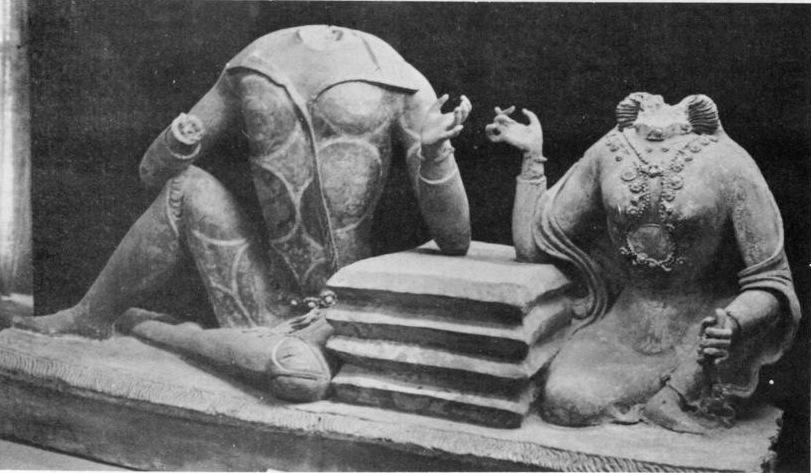Royal Couple, Fondukistan, late 7th-early 8th century

Royal couple, Fonduqestān. (Photograph L. Dupree)

FONDOQESTĀN (FONDUKISTAN), early medieval settlement and Buddhist monastery in Afghanistan, in the province of Parvān (Parwan). The site is situated in the Ḡūrband valley, five kilometers south of Sīāhgerd and 117 kilometers north-east of Kabul, at 34° 58´ N 68° 53´ E. It was named after a village located nearby.
The Fondoqestān site is usually dated to the 7th century C.E. on the evidence of artistic style and numismatic finds, the oldest of which is from 689 C.E. (Göbl, p. 313-14). However, the shape and the decorations of the stupa suggest that the complex can be dated even earlier, around 6th-7th century C.E.
Source: FONDOQESTĀN. Encyclopædia Iranica
Fondukistan is a Buddhist site in the Ghorband valley (Parvan province, Afghanistan), c. 120 km north-west of Kabul. It is located on the top of a hill overlooking the valley from the south, a bit north of the route that passed through the Hindukush, once connected India to Bactria and Central Asia.
Standing out from the overall context of sacred icons is the famous “princely couple” from Niche E. The two figures – the princess in “Indian” dresses, the prince wearing a rich caftan with double lapel and boots – are represented symmetrically and frontally, sitting to either side of a pile of cushions on which they each prop one elbow. Two cinerary urns were found inside the base, all evidence pointing to the princely donors of the portrait sculptures. One of the urns contained a coin of the Sasanian king Khusro II (591–628) which had been countermarked by an Arab governor in 689. This mark offers a valuable clue for dating the sculptures or, at least, the funerary deposit, as it must have been buried after this date.
The decoration of the sanctuary was completed by mural paintings, both inside and outside the niches. The painted figures – among which an image of Maitreya and the personified pair of Sun and Moon – show the same slenderness, gracefulness and bright coloration as the sculptures.
Stylistic comparisons with contemporaneous works in Afghanistan, such as the sculpture of the late phases of Tapa Sardar and the second phase of painting at Bamiyan, and with Tumshuq in Central Asia, the sculpture of Ushkar in Kashmir, and vague affinities with coeval bronze sculpture in Pakistan give witness to a common artistic culture that, albeit with regional variants, in the 7th–8th century CE was shared in a vast territory stretching from Eastern Central Asia to the north-western regions of the Indian Subcontinent.
Source: FONDUKISTAN. The Countenance of the OTHER
Referenced on p113 in "The Representation of Costumes in the Reliefs of Taq-i-Bustan", Artibus Asiae, Vol. 31, No. 2/3, 1969, by Elsie Holmes Peck
'A statue of a seated noble of the sixth to seventh centuries A.D. from Fondukistan is shown with similar boots. Here they seem to be made of supple leather, the pointed front of the boot becoming elongated to form a band which in turn is hidden under the skirt but is presumably attached to an inner belt.'
Referenced as Illustration 157 in Tamara Talbot Rice, Ancient Arts of Central Asia, 1965
Sarcophagus cover: princely couple. Painted terracotta. Fundukistan, Niche E, sixth-seventh century. Kabul Museum.